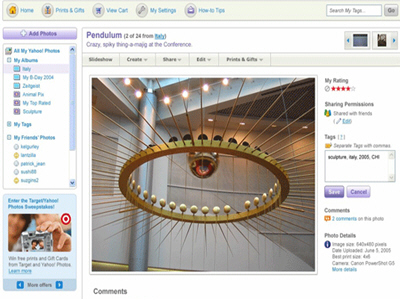Yahoo pours AJAX on photo service

Yahoo Photos has been around since 2000, and has gathered about 2 billion photos and 30 million monthly users. It was early in the game and useful, but not quick to take advantage of Web 2.0 or its sibling Flickr's functionality. The new version (in limited beta in the U.S.) pours on the AJAX, giving it the feel of a rich desktop client application, with slick drag and drop, in line text editing, organizational features, such as automatically updating albums based on tags. Yahoo Photos beta also has integration with other Yahoo services, Mail, Messenger, Mobile and 360. It borrows tagging and comments from Flickr, and Yahoo is partnering with Target for photo finishing services. It also allows users to download original high-res versions of photos.

Yahoo maintains Flickr and Photos as separate services because they cater to different audiences, according to Brad Garlinghouse, senior vice president of communications, community and front doors at Yahoo. Yahoo Photos is aimed at the mass audience, and Flickr has been a favorite of the early adopter, digerati crowd. At some point, I would expect Yahoo to at least have a common repository for the two services, so users could bridge between the two, sharing tags, and Yahoo could just store a single copy.
The new Yahoo Photos is limited to 100 photos per page to optimize the user experience. "Data is dynamically loaded as needed, and we try to keep memory usage down," Schiller said. "Garbage collection isn't perfect, but if you tidy yourself up, you can avoid memory leaks."
"Javascript is dealing with lots of objects, parsing XML, tracking user requests. We are taking advantage of the browser image cache, and we are using Akamai's service for speeding up distributed content delivery," he added. Schiller also said that Yahoo Photos supports some keyboard shortcuts, such as Control-A to selected all text.
For development, Schiller recommends Firefox, although he said that Internet Explorer 6 does a better job of Javascript animation on older systems. Development is sped up by using Yahoo's User Interface Library, written in Javascript, for building applications that use DOM scripting, DHTML and AJAX. "It takes care of issues such as coordinate checking, event handling and collision detection," Schiller said, as well as dealing with the idiosyncracies of different browsers.
"We are taking the scripting language and going crazy with it," Schiller enthused. The results so far with the new Yahoo Photos beta are promising...